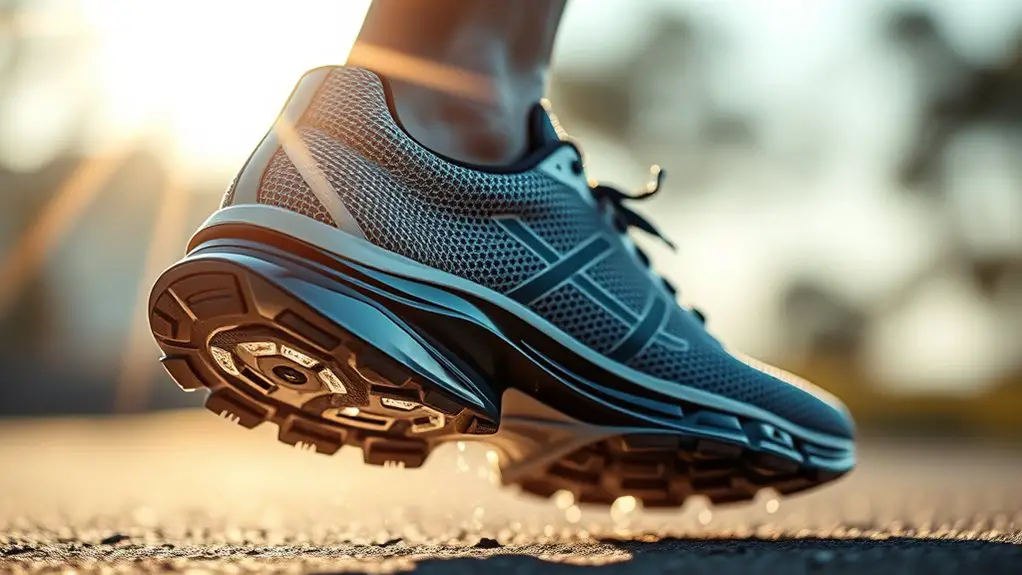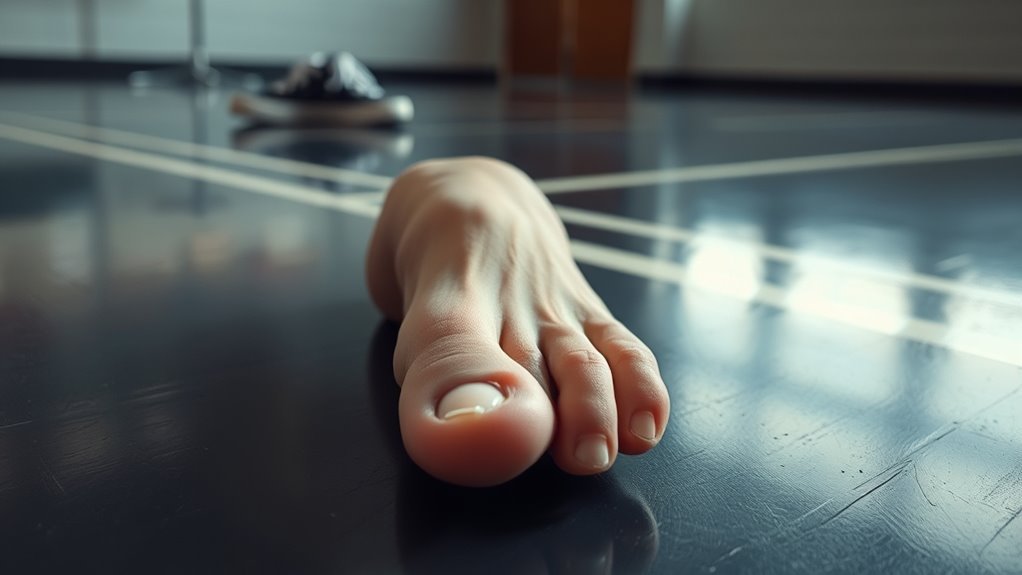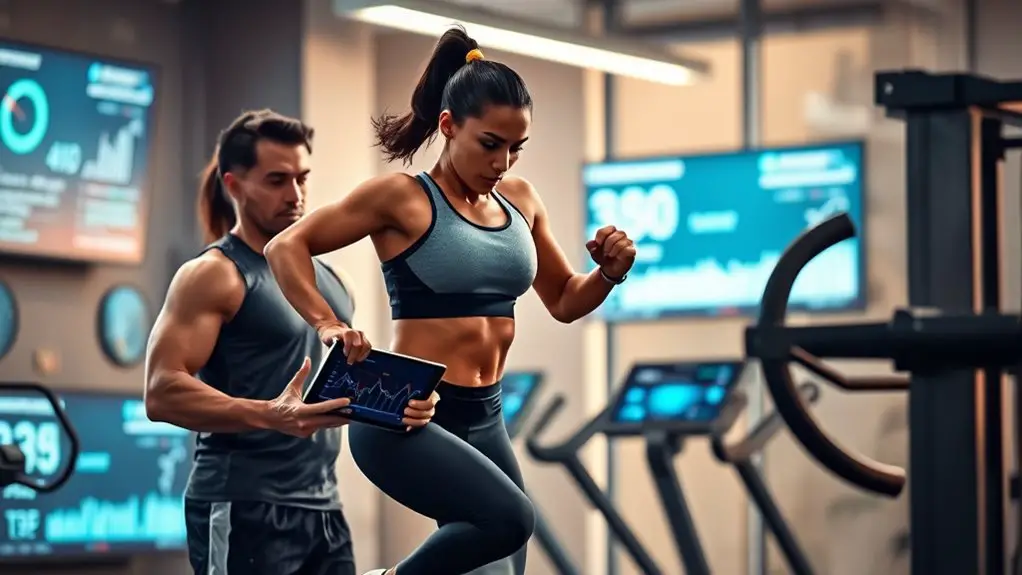Biomechanics is essential in modern running shoe design, affecting your comfort, efficiency, and injury prevention. It involves understanding how your muscles, joints, and running style interact with the ground. Key principles like cushioning, flexibility, and gait-specific features guarantee shoes support your unique needs. Properly designed shoes absorb impact and enhance performance. Exciting innovations are on the horizon that promise even better fit and comfort tailored just for you. Discover how these advancements can elevate your running experience.
Understanding Biomechanics and Its Importance in Running
Biomechanics plays an essential role in how you run and perform, influencing everything from your stride to your overall efficiency. Understanding these principles can liberate you to optimize your running experience. Your body moves in a dynamic way, and each step you take involves complex interactions between muscles, joints, and the ground. When you grasp how your body mechanics work, you can adjust your technique for better speed and reduced injury risk.
You'll find that small changes can lead to significant improvements. For example, aligning your posture or adjusting your foot strike can enhance your power and comfort. By paying attention to your biomechanics, you can unlock your true potential, allowing you to run longer and faster while feeling more in tune with your body. Additionally, embracing proper alignment empowers you to break free from limitations and enjoy every stride you take on the open road.
Key Biomechanical Principles Influencing Shoe Design
When it comes to designing running shoes, understanding key biomechanical principles is vital for enhancing performance and comfort. You should think about how your foot strikes the ground, as this influences the shoe's cushioning and support. A shoe that promotes a natural gait can help you run more efficiently, allowing you to feel that liberating flow as you move.
Additionally, consider the importance of flexibility and stability. A well-designed shoe should adapt to your foot's natural movements while providing enough support to prevent overpronation or supination. Weight is another significant factor; lighter shoes can give you that effortless sensation, promoting speed and agility.
Lastly, traction plays a significant role in maintaining your freedom to explore various terrains. By focusing on these principles, you'll find a shoe that not only complements your running style but also enhances your overall experience.
The Impact of Cushioning on Performance and Injury Prevention
Cushioning plays an essential role in how well you perform and how effectively you can prevent injuries while running. The right cushioning can absorb impact, support your feet, and enhance comfort, allowing you to focus on your stride. This balance can ultimately lead to improved performance and reduce the risk of injuries like stress fractures or joint pain. Staying hydrated is also crucial, as proper hydration helps maintain energy levels and prevent fatigue during your runs.
Here's a quick look at the benefits of cushioning:
| Benefit | Description |
|---|---|
| Shock Absorption | Reduces impact on joints |
| Comfort | Enhances overall running experience |
| Energy Return | Helps propel you forward |
| Stability | Provides support for your stride |
| Injury Prevention | Minimizes stress on feet and legs |
Choosing the right level of cushioning can empower you to run longer and stronger, ensuring you enjoy the freedom of movement without the worry of injury. Your feet deserve that!
Tailoring Running Shoes to Individual Gait Patterns
Finding the right cushioning is just one piece of the puzzle; understanding your unique gait pattern is equally important when selecting running shoes. Your feet and stride tell a story about how you run. By analyzing your gait, you can identify whether you overpronate, underpronate, or have a neutral stride. This insight can help you choose shoes that provide the support and stability you need, allowing you to run freely without discomfort.
Many brands now offer shoes tailored to different gait patterns, ensuring you find the perfect fit for your natural movement. Additionally, assessing your gait can significantly enhance your shoe selection process. Don't just grab any shoe off the shelf—take the time to try on various options and see how they feel. A well-fitted shoe can enhance your performance, reduce injury risk, and make every run a more enjoyable experience. Embrace the freedom of running by choosing shoes that align with your unique biomechanics.
The Future of Biomechanics in Running Shoe Innovation
As technology advances, the future of biomechanics in running shoe innovation promises to revolutionize how we approach footwear design. You're on the brink of experiencing shoes that not only support your performance but also adapt to your unique running style. Here are three exciting developments to look forward to:
- Smart Materials: Expect shoes made from materials that dynamically adjust their stiffness and cushioning based on your foot's movement and pressure.
- 3D Printing: Customized shoes tailored to your specific biomechanics will become mainstream, allowing for a perfect fit that enhances comfort and performance.
- Data Integration: Imagine shoes equipped with sensors that provide real-time feedback on your gait, helping you optimize your run and minimize injury risk.
These innovations will give you the freedom to run more efficiently and comfortably, making each stride feel effortless. The future's bright for runners who crave individuality in their gear!
Frequently Asked Questions
How Often Should I Replace My Running Shoes?
You wouldn't want to run on clouds that have lost their fluff! Replace your running shoes every 300-500 miles, or when you notice signs of wear. Your feet deserve the best for that freedom you crave!
Can Biomechanics Improve My Overall Running Speed?
Yes, biomechanics can definitely improve your overall running speed. By analyzing your form and movement, you can identify areas for enhancement, leading to more efficient strides and ultimately faster times. It's all about optimizing your natural abilities!
What Are the Signs of Worn-Out Running Shoes?
Like a trusty steed showing its age, worn-out running shoes might have uneven wear, reduced cushioning, visible cracks, or discomfort while running. If you feel more aches, it's time to set those shoes free!
Do Running Shoes Affect Long-Term Joint Health?
Yes, running shoes do affect long-term joint health. If you choose poorly fitting or worn-out shoes, you might experience joint pain and discomfort. Prioritizing proper footwear can help keep your joints happy and healthy.
How Important Is Shoe Fit Compared to Biomechanics?
When it comes to shoe fit versus biomechanics, you can't underestimate the importance of a proper fit. A snug shoe lets you run free, while biomechanics helps prevent injuries. Both work hand in hand for peak performance.




